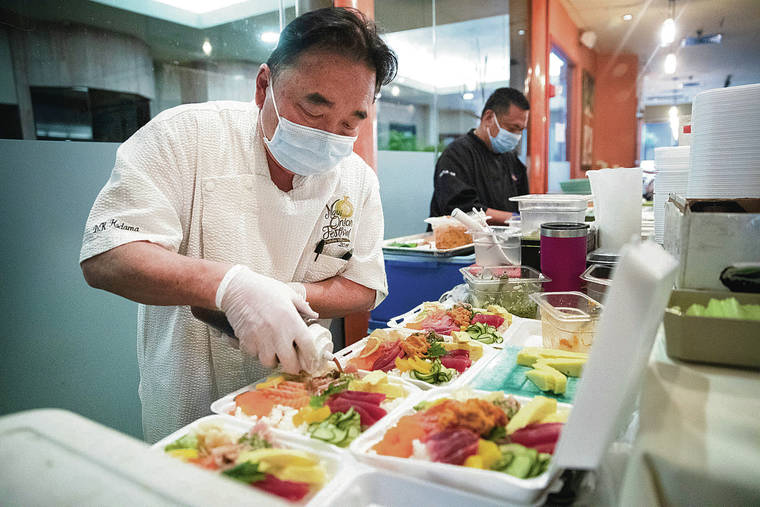Oahu restaurant owners fear effects of shutdown

GEORGE F. LEE / GLEE@STARADVERTISER.COM
DK Kodama consolidated his three restaurants to offer takeout from his Vino location. “Better safe than sorry,” he said about the second shutdown. “You’re talking health and family versus business and making money. What comes first? Health and family, of course.” At left, Kodama, left, building chiraishi plates with Head Sushi Chef Greg Gabaoan at Vino.
Oahu restaurant owners understand the reasons behind a two-week dining-room shutdown Opens in a new tab that begins Thursday, but they are still frustrated and fearing the worst.
“We’re struggling to stay afloat and provide jobs,” said Victor Lim, one of the chairpersons of the Hawaii Restaurant Association and owner of five McDonald’s restaurants in Hawaii. “It’s ugly. Actually, that’s an understatement.”
A city announcement Tuesday restricted restaurants once again to takeout operations. The last shutdown, at the beginning of the pandemic, ran from mid-March until early June.
While health and safety must come first, Lim said, “the sustainability of businesses in the state are at a critical juncture. Summertime is usually a time to build cash flow, but this year there is no such reserve for businesses to sustain themselves.”
Two weeks may not seem like a long time, said Lane Muraoka, founder and owner of Big City Diner. “But anyone who owns a small business knows that is a long time because your cash flow decreases but the bills don’t. The invoices keep coming in. Overhead will be a big challenge.”
Forty Hawaii restaurants — 20 on Oahu — have permanently closed since the pandemic began, according to a list compiled by Food-A-Go-Go, a restaurant support group that falls under the Hawaii Agricultural Foundation.
Don't miss out on what's happening!
Stay in touch with breaking news, as it happens, conveniently in your email inbox. It's FREE!
Denise Yamaguchi, executive director of the foundation, said her fear is that more won’t survive this second shutdown, as many were just getting back on their feet. “I can’t even guess where we’ll be after two weeks.”
The one consolation, Yamaguchi said, is the government’s plan to increase contact tracing and testing. “If we make this two-week sacrifice, it’s hopeful that our leaders will have enough information so we don’t have to go backward again.”
Lim said the city, state and Department of Health must work alongside the business community. “We need leadership to ensure this is handled correctly. We take one step to the left, two steps to the right. We need to have the coordinated effort on everyone’s part to march forward.”
Muraoka said he’s already cut his staff in half to 250 employees, many of whom will now be placed “on hiatus.”
“Your servers, there’s no work for them now,” he said. “Some office staff, hourly workers, dishwashers … As a business owner my objective is always to keep everyone working. But the sad reality is we already have less than half the business as it is.”
He also lamented the trickle-down effect, as vendors suffer when restaurants cancel orders. “Their drivers, their stockers. It snowballs downhill fast when we order even less meat, less tomatoes, even when we order less supplies like paper towels. People end up losing jobs.”
Jeremy Shigekane, chef/owner of M by Chef Mavro, had just reopened for outdoor dining and was hoping to serve diners inside in a few weeks.
The restrictions placed on restaurants are “like a good jolt, every time,” Shigekane said. “Just when we get used to something, it’s like a good kick in the face. It keeps me on my toes.”
He spoke to his staff of six about “the what-ifs.” “I asked, ‘Is it worth our time to stay open?’ We decided to do something so we can say that at least we tried.”
DK Kodama, owner of the DK Restaurant Group, said he is better prepared for this shutdown because he’s had time to build a takeout business, which now contributes about half his revenue.
Kodama consolidated his three Oahu restaurants — Vino Italian Tapas & Wine Bar, Sansei Seafood Restaurant & Sushi Bar and d.k Steak House — to offer dine-in and takeout from the Vino location in Kakaako. But takeout can’t replace sit-down dining in the long run, he said.
Although this second shutdown was expected, he had still hoped it could be avoided. “But better safe than sorry. You’re talking health and family versus business and making money. What comes first? Health and family, of course.”
———
Star-Advertiser staff writers Joleen Oshiro and Dave Reardon contributed to this report.



